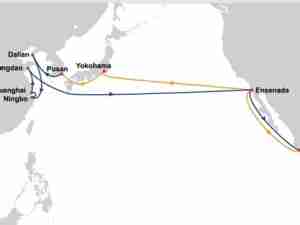Shipping on the Great Lakes saves its customers more than $3.6 billion a year when compared to the next least costly mode of transportation. That is the conclusion of a report prepared for the US Army Corps of Engineers by the Tennessee Valley Authority. The soon-to-be-released report tracked the movement of 11 commodities on the Great Lakes, shipments of which totaled 173 million tons in 2006. These cargos represent 10% of all US domestic waterborne commerce.
What makes these savings even more important is the geographic location of the Great Lakes.
They are in the core of North America's industrial and manufacturing heartland. The prosperity of several key sectors of the US economy depends on Great Lakes shipping. Among these sectors are iron mining and steel production, power generation, and agricultural exports, and their viability is directly tied to the availability of reliable, low-cost waterborne transportation.
The Corps study also finds Great Lakes shipping a major source of jobs. There are 44,000 jobs directly related to maritime transportation. Another 54,000 jobs in the mining industry and 138,000 jobs in the steel industry are dependent on Great Lakes shipping. Those industries, the study stresses, then sustain hundreds of thousands of additional jobs in manufacturing industries.
Great Lakes shipping also outperforms the land-based modes of transportation in fuel efficiency and environmental impact. A Great Lakes freighter travels 607 miles on one gallon of fuel on a per-ton-of-cargo basis. A truck travels only 59 miles; a train, just 202 miles.
In terms of emissions, Great Lakes vessels are vastly superior to the land-based modes, producing 90% fewer emissions than trucks, and 70% fewer emissions than trains.
The Corps study also addresses the critical needs of maintaining the Great Lakes navigation system. Topping the priority list is restoring existing locks and building a new Poe-sized lock at Sault Ste. Marie, Michigan. The Corps has estimated that a 30-day unscheduled closure of the Soo Locks would cost industry $160 million. Without the Poe Lock, America' steel industry would be cut off from its major source of iron ore.
Clearing the dredging backlog is also a major priority. The backlog of sediment that must be removed to restore ports and waterways to their proper depth has reached an unprecedented level: 17 million cubic yards. When harbors and channels shoal in, ships have to light load, which increases transportation costs because more trips are required. The Corps estimates it will need more than $200 million to clear the backlog of sediment.
Other needs that must be addressed are the dwindling capacity at Confined Disposal Facilities that store sediment that is not suitable for open water disposal, and restoration of breakwaters and structures that safeguard commercial navigation and provide critical flood and storm protection.
'This Corps study confirms that Great Lakes shipping is a lynch pin of the US economy,' said James H.I. Weakley, President of Lake Carriers' Association.
'Great Lakes shipping is also the greenest form of transportation,' continued Weakley. 'We have, however, as a nation, neglected Great Lakes shipping. The dredging crisis is unconscionable.
Imagine what the savings would be if ships could carry full loads. The second Poe-sized lock was first authorized more than 20 years ago, yet remains unbuilt. The hoped-for recovery of our economy will not be as robust if we do not invest in Great Lakes shipping.'
Weakley addressed these and other issues at a January 22 hearing of the House of Representatives' Transportation & Infrastructure Committee. He told legislators that 'no other project is better suited for inclusion in an economic stimulus package than construction of a second Poe-sized lock ' It will ensure the continued free flow of raw materials on the Great Lakes ' This single project has national security, job creation, and transportation efficiency aspects.'
Alth





